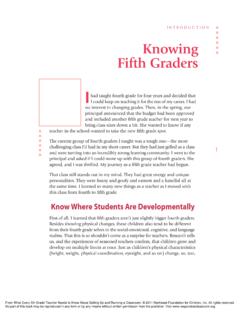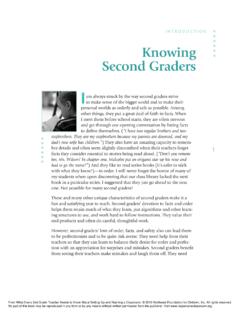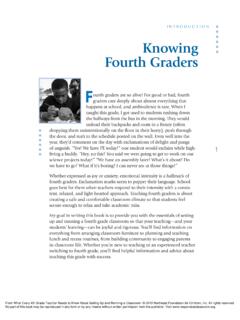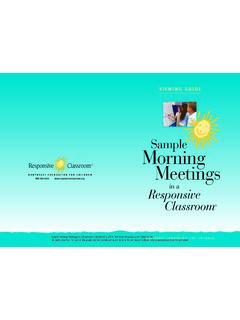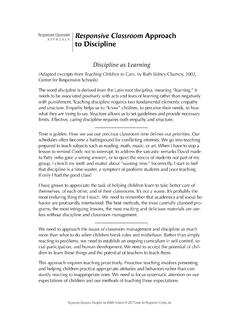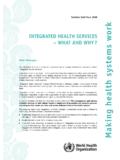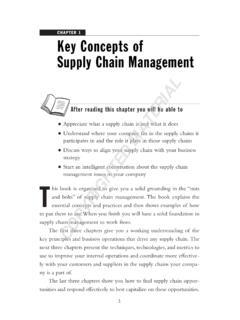Transcription of Strengths and Areas of Growth Assessment Example
1 Positive CommunityEffectiveManage-mentEngaging AcademicsDevelop-mentally ResponsiveTeachingStrengths and Areas of Growth Assessment ExampleStrengthsAreas of Growth Morning Meetings are held eachday Teacher speaks with a calm andrespectful voice Classroom displays are mostly stu-dent work and include examplesfrom everyone in the class Students know the procedures inthe classrooms and most commonareas Teachers use Interactive Modelingto teach classroom expectations Teacher communicates the pur-pose of activity/lesson to students Teacher has tried to include Academic Choice a few times this year Teacher considers students developmental needs when setting up the classroom Teacher scaffolds lessons that are outside of students develop-mental abilities Increase use of activities duringMorning Meeting that promotecollaboration and inclusiveness Model and practice offering respectful questions and com-ments during Morning Meetingsharing Consistently observe studentsduring transitions throughout the day Use wait time after the signal to gain the class s attention Create more active/interactivelessons Allow students more choice Embed energizers or interactivelearning structures
2 Throughoutlessons Increase movement/interactionthroughout the day to meet students needs Responsive ClassroomPlanning Session 2017 Center for Responsive Schools, Inc. Sample GoalsFocus on teaching and practice of social, emotional, and academic competencies: Identify specific social, emotional, andacademic competencies that are chal-lenging for students. Create a timeline for when to teach thecompetencies on the list. Use Interactive Modeling to introduceand practice these skills (taking turns,saying Excuse me, turning in home-work each day, persevering throughtough math problems ..).
3 Record Interactive Modeling lessons or have a colleague observe to notestrengths in my lesson and in the stu-dents practice as well as Areas to target for further Interactive Modeling. Search for and read related articles onthe Responsive Classroomwebsite aswell as the Interactive Modeling book. Find a learning partner within school or online who wants to work towardthe same goal and plan periodic meet-ings to assess progress, celebrate successes, and plan for next steps. Plan Morning Meeting/Responsive Advisory Meeting components that address social, emotional, or aca -demic competencies. Use teacher language to remind and reinforce targeted social, emotional,and academic components of engaging academicsinto each lesson: Re-familiarize myself with the char-acteristics of engaging to include at least one ortwo of those characteristics into eachlesson I plan.
4 Book study of The Joyful Classroomto gain more ideas for creating engaging academics. Look at content and pacing for thenext month. Decide when AcademicChoice would be an effective struc-ture for a lesson or lessons. Plan theAcademic Choice lesson using astructure similar to the examples in The Joyful Classroom .After the Academic Choice lesson,reflect on successes and Areas forgrowth with implementation. Usethat to plan the next AcademicChoice lesson. Observe students. When do they typ-ically need movement breaks duringthe day? Plan one additional move- ment break to meet their they are successful, add an-other movement break as needed.
5 Use Interactive Modeling to teachstudents an interactive learning struc-ture at Morning Meeting. Use thesame interactive learning structurelater in the day during an academiclesson. Responsive ClassroomPlanning Session 2017 Center for Responsive Schools, Inc. Responsive ClassroomPlanning Session 2017 Center for Responsive Schools, Inc. Align my discipline practices with Responsive Classroompractices. Book study of Rules in School. Watch a video clip with responding to misbehavior in mind. Notice theteacher s tone, body language, andchoice of how to intervene. Plan to self-assess using the disciplinecomponents of theResponsive Class-room Assessment Tool for Teachers.
6 Invite a colleague to observe or recordmyself throughout a time of day that ischallenging to see how I respond tomisbehavior (language used, type oflogical consequence and result, tone,body language). Look for related articles on the Respon-sive Classroomwebsite and read inde-pendently or as a grade level team. Evaluate how well I know my studentsculturally, academically, and individu-ally and use that data to strengthen relationships. Identify a teacher with strong Respon-sive Classroomdiscipline practices my use of positive teacher languageand deepen my understanding of that practice. Book study of The Power of OurWords.
7 Self-assess using the teacher languagecomponents of the Responsive Class-room Assessment Tool for Teachers. Hang sentence stems around the roomas cues. Identify colleagues who are strong intheir use of positive teacher languageand set up a time to observe. Record a lesson, then evaluate howmuch of each type of language I usedthroughout. As I plan lessons, consider what open-ended questions could be added to thelesson and add them directly to theplan. Watch a video clip from ResponsiveClassroomon YouTube and pay atten-tion to tone, body language, and wordchoice of the teacher. Responsive ClassroomGoal-Setting Planning Sheet Choose a focus A strength you want to continue to improve An area that is not as strong A problem that has already been identified and you are looking for a solution Create subtopics How will this focus be broken down?
8 Choose and plan projects What projects will help achieve the overarching goal?Responsive ClassroomPlanning Session 2017 Center for Responsive Schools, Inc. Logistics How long/how often will this be worked on? What support might you need? Who might be able to provide you with that support? How will you know if you are making progress toward your goal? What changesmight you expect if you are making progress toward your goal? Resources What resources will you use? (blogs, articles, books, consultants, panel members) Where are these resources located?Responsive ClassroomPlanning Session 2017 Center for Responsive Schools, Inc.
9

